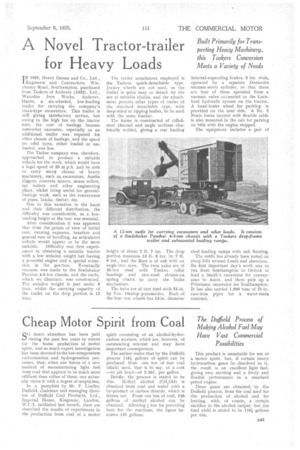A Novel Tractor-trailer for Heavy Loads
Page 57

If you've noticed an error in this article please click here to report it so we can fix it.
Built Primarily for Transporting Heavy Machinery, this Taskers Conversion Meets a Variety of Needs
I N 1929, Henry Osman and Co., Ltd., Engineers and Contractors, Winchester Road, Southampton, purchased from Taskers of Andover (1932), Ltd., Waterloo Iron Works, Andover, Hants, a six-wheeled, low-loading trailer for , carrying the company's track-type excavators. This trailer is still giving satisfactory service, but owing to the high tax on the tractor unit, the cost of haulage became somewhat excessive, especially as an additional trailer was required for other classes of haulage, and the speed on solid tyres, either loaded or un loaded, was low. • The Tasker company was, therefore, approached to produce a suitable vehicle for the work, which would have a legal speed of 20 m.p.h. and he able to carry many classes of heavy machinery, such as. excavators, Austin diggers, concrete mixers, steam rollers, tar boilers, and other engineering plant, whilst being useful for generalhaulage work, such as the conveyance of pipes, bricks, timber, etc.
Due to this variation in the loads and their different distribution, the difficulty was cohsiderable, as a lowloading height at the rear was essential.
After consideration it was apparent that from the points of view of initial cost, running expenses, taxation and general ease of handling, an articulated vehicle would appear to be the most
suitable. Difficulty was first experienced in obtaining a suitable tractor with a low unladen weight but having a powerful engine and a special reduction in the gearbox. Eventually recourse was made to the Studebaker Panther 4-5-ton chassis, and the outfit, which we illustrate, was constructed. The unladen weight is just under 6 tons, whilst the carrying capacity cf the trailer on the drop portion is 12 tons.
The trailer attachment employed is the Taskers quick-detachable type, jockey wheels are not used, as the trailer is quite easy to detach by the use of suitable chocks, and the attachment permits other types of trailer of the standard detachable type, with deep-sided or tipping bodies, to be used with the same tractor.
The frame is constructed of rolledsteel channel and angle sections electrically welded, giving a rear loading height of about 2 ft. 7 ins. The drop portion measures 13 ft. 8 ins. by 7 ft. 6 ins., and the floor is of oak with an angle-iron rave. The twin axles are of 45-ton steel with Timken roller bearings and cast-steel shrunk-cu spring chairs to carry the brake mechanism.
The hubs are of cast steel with 24-in. by 7-in. Dunlop pneumatics. Each of the four rear wheels has 15-in, diameter infernal-expanding brakes, 3 ins, wide, operated by a separate Dewandre vacuum-servo cylinder, so that there are four of these operated from a vacuum valve connected to the Lockheed hydraulic system on the tractor. A hand-brake wheel for parking is provided on the near side. A No. 2 Neate brake control with flexible cable is also mounted in the cab for parking on hills with the engine stopped.
The equipment includes a pair of steel. loading ramps with oak flooring.
The outfit has already been tested on steep hills around Leeds and elsewhere. Its first important day's work was to run from Southampton to Oxford to load a Smith's exca.vator for conveyance to Ascot, and there pick -up a Thiestrnan excavator for Southampton. It has also carried 1,900 tons of 21-in, cast-iron pipes for a water-main contract.




























































































